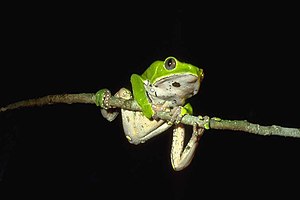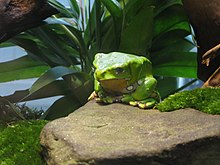Giant macro frog
| Giant macro frog | ||||||||||||
|---|---|---|---|---|---|---|---|---|---|---|---|---|

Giant Maci Frog ( Phyllomedusa bicolor ) |
||||||||||||
| Systematics | ||||||||||||
|
||||||||||||
| Scientific name | ||||||||||||
| Phyllomedusa bicolor | ||||||||||||
| ( Boddaert , 1772) |
The giant macro frog ( Phyllomedusa bicolor ) is a species of the genus Makifrosch , which belongs to the family of griffin frogs (Phyllomedusidae). Alternative names are Blue-Yellow Frog , Two-colored tree frog , giant monkey frog , giant tree frog and guard monkey tree frog .
description
The head-trunk length of males measures between 91 and 103 mm, females can reach 111 to 119 mm. The back is lime green, while the belly is white to yellow-white or cream-colored. The lower lip, chest and forelegs have isolated white spots with a dark border; these are more densely arranged on the flanks and hind legs. The fingers are transparent brown and have large, green adhesive discs. Behind each eye there is a prominent gland that extends over the tympanum (Latin: membrana tympani ). The iris is dark gray.
Their body shape looks unusually angular for frogs . Maki frogs can face their fingers and toes; as a result, they can also encompass thinner parts of plants and climb up on them - they are considered excellent climbers.
Synonyms of the species are Rana bicolor and Hyla bicolor (Boddaert, 1772).
Occurrence and way of life
The giant macro frog is found in the rainforests of South America . It is distributed throughout the Amazon rainforest in northern Bolivia , western and northern Brazil , southeastern Colombia , eastern Peru , southern and eastern Venezuela, and the Guyanas . Occasionally it is also found in the alluvial forest area of the Cerrado , an extensive tropical savannah in the Brazilian state of Maranhão.
Phyllomedusa bicolor is a nocturnal tree-dwelling frog. The animals spend the day in dry, warm places. To protect against dehydration, they cover their skin with a waxy layer. At night they go in search of food for spiders and insects. Giant lemur frogs move slowly by climbing. Only when a prey is within range do they snap shut at lightning speed. In the rainy season they seek out the water.
During the mating season , the males call from the trees to attract females. The males fight for mating rights by using their heads to try to separate another male that is already attached to a female, and they use their hind legs to ward off rivals. In addition, they make aggressive sounds; As a result, the males are often targeted by predators , as the fights between the males are very loud and can easily be heard by predators . To counteract this, Phyllomedusa bicolor produce peptides in their skin that are used for chemical defense.
During mating, the male climbs onto the back of the female and clasps her in the amplexus with the forelimbs under the armpits. The male is carried around by the female in order to be able to fertilize the eggs as soon as they are laid. Females and males build a leaf nest above forest pools, in which the eggs are deposited in a gelatinous mass about 70 cm above the water level ; the leaves are also rolled up to protect the clutch from enemies and drought. The tadpoles hatch from the eggs after about 14 days and fall into the water below, where they continue to develop into adult frogs. The peak of reproduction occurs during the rainy season .
The eggs of the giant macro frog are a coveted food for numerous predators and have a predation rate of up to 61 percent. The identified species that eat the protein-rich eggs include ruffflies and humpback flies , but also primates such as the crested capuchin (Latin: Cebus apella ) and other predators such as snakes .
Systematics and species protection
The Maki frogs have long been part of the tree frog family (Hylidae). By the IUCN led IUCN Red List lists the Riesenmakifrosch in the category "Least Concern" (LC; German Least concern ), given its currently widespread and large population.
Use in medicine
The skin secretion of the giant macro frog ( Brasil . Kambô ) is known as "Vacina do sapo" (Brasil. For frog vaccine ); it contains the opioid peptides deltorphin, deltorphin I, deltorphin II and dermorphin . The secretion is used in cleansing rituals, which are also known colloquially as sapo or kambô cleansing; these trigger violent body reactions such as vomiting .
The medical effectiveness has not yet been proven by medical studies.
Individual evidence
- ↑ Frost, Darrel R .: Phyllomedusa bicolor (Boddaert, 1772) . In: Amphibian Species of the World: an Online Reference. Version 6.0 . American Museum of Natural History. 2015. Retrieved August 25, 2015.
- ↑ Phyllomedusa bicolor giant tree frog . Retrieved August 25, 2015.
- ↑ Phyllomedusa bicolor . In: AmphibiaWeb: Information on the biology and protection of amphibians. . Berkeley, California: AmphibiaWeb. 2015. Retrieved August 25, 2015.
- ↑ a b IUCN Redlist: Phyllomedusa bicolor
- ↑ Nathocley Venâncio, Paulo Melo Sampaio: reproductive behavior of the giant tree frog Phyllomedusa bicolor (Anura: Hylidae) in the western Amazon region . In: Phyllomedusa: Journal of Herpetology . 9, No. 1, 2010, pp. 63-67. doi : 10.11606 / issn.2316-9079.v9i1p63-67 .
- ↑ Selvino Neckel-Oliveira, Milena Wachlevski: Predation on the Arboreal Eggs of Three Species of Phyllomedusa in Central Amazonia . In: Journal of Herpetology . 38, No. 2, 2004, pp. 244-248. doi : 10.1670 / 162-03A .
- ↑ Francisco Vaniclei Araújo da Silva, Wuelton Marcelo Monteiro, Paulo Sérgio Bernarde: "Kambô" frog (Phyllomedusa bicolor): use in folk medicine and potential health risks . In: Revista da Sociedade Brasileira de Medicina Tropical . 52, 2019, ISSN 1678-9849 , p. E20180467. doi : 10.1590 / 0037-8682-0467-2018 . PMID 30942261 .
- ↑ S. Castroviejo-Fisher, J. Koehler, I. De la Riva & JM Padial: A new morphologically cryptic species of Phyllomedusa (Anura: Phyllomedusidae) from Amazonian forests of northern Peru revealed by DNA sequences. Zootaxa 4269, 2, pp. 245-264, May 2017.
- ↑ Deltorphins: a family of naturally occurring peptides with high affinity and selectivity for delta opioid binding sites . In: Proceedings of the National Academy of Sciences of the United States of America . 86, No. 13, July 1989, pp. 5188-92. bibcode : 1989PNAS ... 86.5188E . doi : 10.1073 / pnas.86.13.5188 . PMID 2544892 . PMC 297583 (free full text).
- ↑ Peptide secretion in the skin glands of the South American tree frog Phyllomedusa bicolor . In: European Journal of Cell Biology . 79, No. 9, September 2000, pp. 631-641. doi : 10.1078 / 0171-9335-00085 . PMID 11043404 .
- ↑ The dermorphine family of peptides . In: General Pharmacology: The Vascular System . 27, No. 7, 1996, pp. 1099-107. doi : 10.1016 / 0306-3623 (95) 02149-3 . PMID 8981054 .
- ^ Opioid peptides from frog skin ( ISBN 978-3-0348-9794-5 ) . In: EXS . 85, 1998, pp. 57-71. doi : 10.1007 / 978-3-0348-8837-0_4 . PMID 9949868 .
- ↑ The syndrome of inappropriate antidiuretic hormone secretion after exposure to the venom of the giant tree frog ( Phyllomedusa bicolor ) . In: Toxicon . 120, 2016, pp. 107-109. doi : 10.1016 / j.toxicon.2016.07.007 . PMID 27421671 .
- ^ A b Max Daly: How Amazonian Tree Frog Poison Became the Latest Treatment for Addiction . In: Vice , May 10, 2016. Archived from the original on September 7, 2018. Retrieved on October 31, 2018.
- ↑ Angela Lavoipierre: Tree frog poison is used as an alternative medicine . In: ABC Australia , September 6, 2018. Archived from the original on September 7, 2018. Retrieved on September 7, 2018.
Web links
- IUCN Redlist: Phyllomedusa bicolor (Engl .; including distribution map)
- Erowid: Phyllomedusa bicolor (English)
- Summary of an English-language publication on the skin toxins of certain Phyllomedusa species , full text

